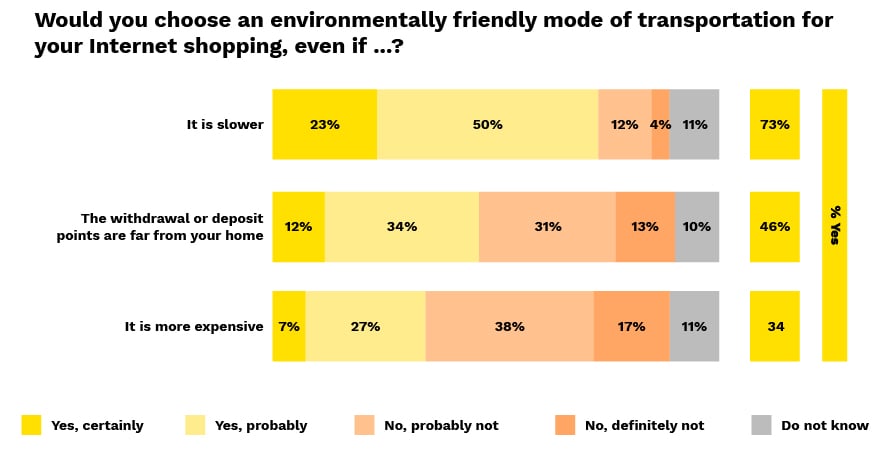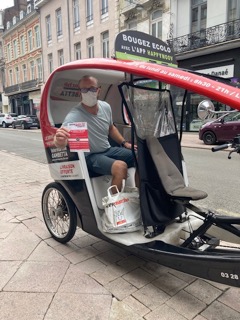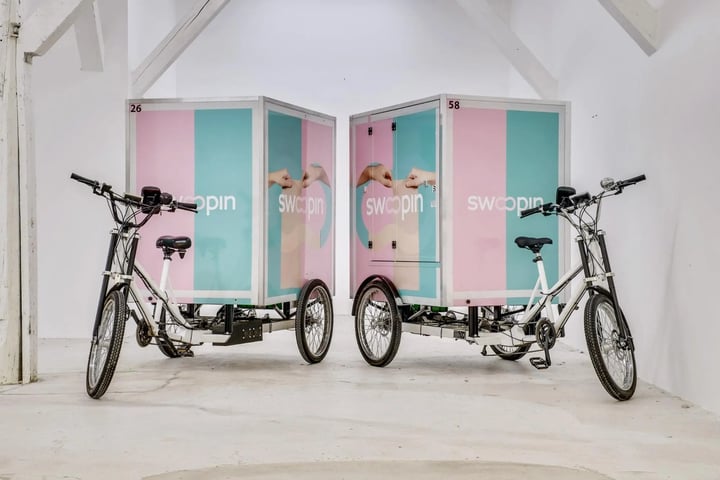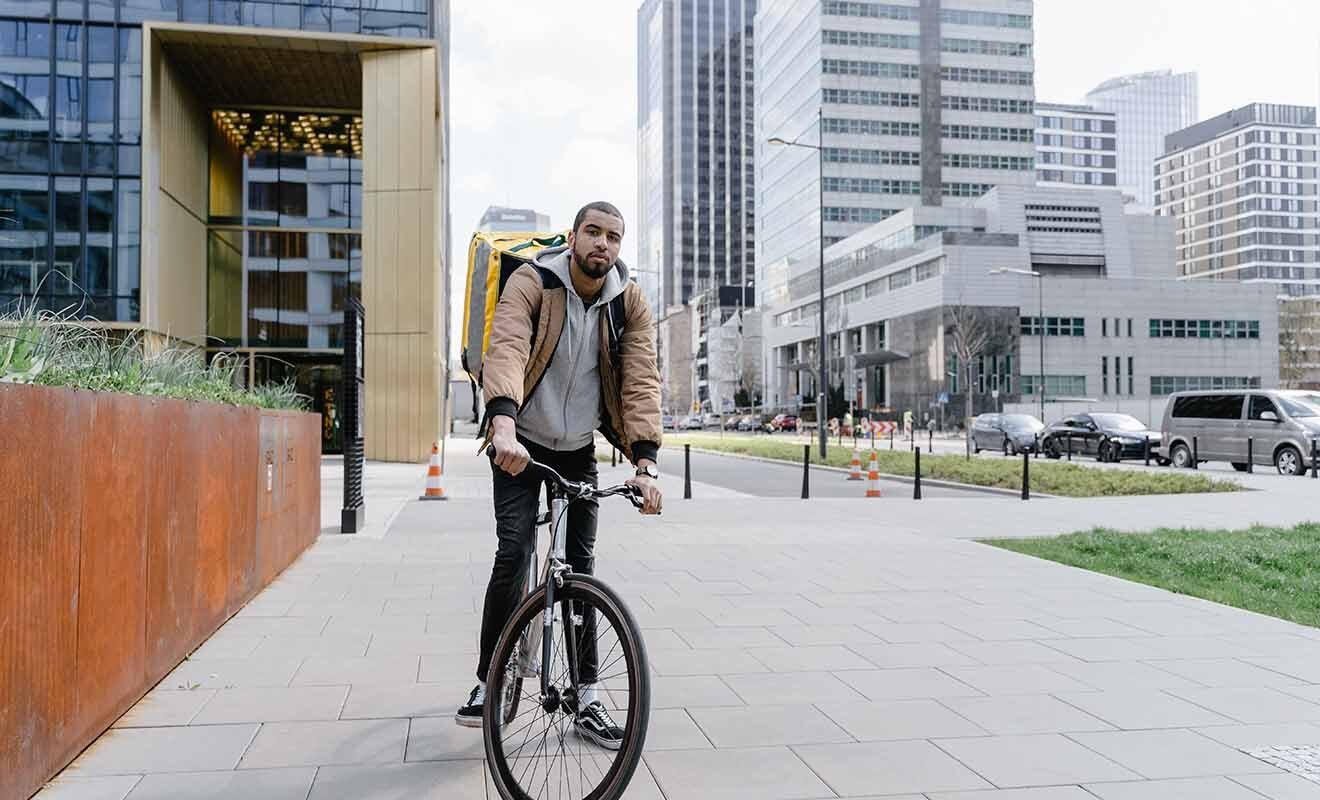Cycle logistics, the future of urban deliveries
.webp)
The last mile is the final delivery stage and, more often than not, the most expensive. It is the most costly financially, as well as environmentally.
According to figures published by Rungis' international market strategic analysis committee, this represents around 20% of urban traffic, occupies 30% of roads and is the source of 25% of greenhouse gas emissions.

A close look at digital technology
In 2019, 40 million French people made Internet purchases and 85% of them had their items delivered to their homes. And on 17 December 2019, the Post Office recorded its highest ever number of parcels delivered in one day: 3.1 million.
The ecological impact of e-commerce is starting to weigh heavily.
According to the Environment and Energy Management Agency, an online purchase emits an average of 12 grams of CO2, or the equivalent of one kilometre by car. If this figure doesn’t seem like much to you, think about the fact that in 2019, in France, more than a million packages were delivered to homes ... a day.
It' time to make delivery greener.
Let’s now take a look at what consumers think about it, as well as how cycle logistics is emerging as an obvious solution to this environmental issue.
What do consumers think?
According to a recent study by Generix group, 87% of French people say they’re interested in a greener delivery method. They say they can wait longer for their package, but are not prepared, however, to pay more for a greener delivery method.

Young people are the most sensitive to environmentally friendly transport. 86% of 25-34-year-olds are happy to pay more for a mode of transport that’s more respectful of the environment.
Cycle logistics, a simple bicycle?
Cycle logistics isn’t just a bicycle... There are in fact several vehicle types.
Here are a few:
- Two-wheel cargo bike
"The two-wheel cargo bike: this is a two-wheeled bicycle that can significantly improve transport capacity. In an urban environment, it’s the ideal vehicle for running errands, in other words, making a dedicated delivery from a departure point to an arrival point. Its maximum capacity is between 50 and 80kg, which is significant and covers 90% of food shopping deliveries."
- Florent Fournier, Applicolis
- Tricycle cargo bike, three-wheeled bike.
- The trailer bike / K-ryole
"The advantage of these vehicles is that they combine the benefits of the bike and the van, taking the best of both worlds: the 1m3 capacity can handle multiple orders - between 8 and 10 orders per load - and carry out delivery rounds, while using cycle paths usually reserved for cycling. The time savings per delivery are quite substantial, as are the environmental benefits."
- Dimitri Moulin, Stuart
- Taxi-Bikes
This hybrid version links the transport of people and goods.
Their versatility and the network of taxi-bikes make them an extremely responsive solution for your deliveries. Ideal for grocery shopping within a radius of a few miles around the store.

"What's stopping you from grabbing an extra bottle of wine or buying that shelving unit? Bring your shopping to your door! The solution: HAPPYMOOV bicycle taxis. With its carrying capacity (-> 200kg) and responsiveness, the bicycle taxi is the perfect solution. Do your shopping in store or at the drive-through, and Happymoov delivers your shopping."
- César Coisne, Happymoov
What are the advantages and obstacles to the development of these vehicles?
Although there are numerous advantages of these vehicles, some are still unknown to the general public.
Let's start with the most obvious, then - the benefits for society and our city centres: silent, environmentally friendly transport.
For the carrier, the first advantage is a significant financial gain. The cost of purchasing a bicycle is significantly cheaper than a commercial vehicle, as are the maintenance and repairs. Enough to make you want to go green!

"The purchase cost of a cargo bike is €5,000 excl. VAT, maintenance is €80/month, and you need €15/month for insurance. For a bicycle trailer, the purchase cost is between €2,000 and €5,000 and maintenance costs between €10 and €80, depending on the technology. These are for professional vehicles. In reality, there are cheaper models, but they are not suitable for intensive transport"
- Florent Fournier, Applicolis
However, this needs to be qualified with electrically assisted vehicles which are more expensive. The second advantage is the ease of fulfilling the delivery service in urban areas.
"The bicycle, as a means of transport, is particularly effective in dense, congested French towns, because they can easily travel on cycle paths which are experiencing exponential growth and connect point A to point B almost twice as fast as a van held up by traffic jams."
- Dimitri Moulin, Stuart
The third advantage is perhaps the one that guides a bike transport offer the most: the respect for its customer commitment.
Thanks to their bike, delivery riders avoid traffic jams and other traffic hazards. Free, easy parking makes them even more efficient in fulfilling and keeping their promise to the end customer.
"These vehicles are unaffected by traffic and parking, which is ideal for delivering small packages in urban areas."
- Benjamin Levine, Tous Facteurs.
It goes without saying that this also represents an advantage for the end customer, a delivery promise that’s met with an environmental conscience.
However, there are a few obstacles that hamper the development of these vehicles:
Electric bikes have a short range and long charging time. Some cities lack cycle paths, and the development of infrastructure is essential for the growth of cycle logistics.
Finally, it has to be said that while this mode of delivery works very well in urban areas it remains underdeveloped in rural areas because of its unsuitability (longer distances are the main reason).

How can responsible bicycle delivery be made more accessible?
Cycle logistics is still unfamiliar to the general public. We must therefore first highlight the capacities of this type of delivery and the associated vehicles (many people still believe that capacities are limited to small packages whereas household appliances can be transported)
Raise awareness among several targets:
- Carriers
They, as well as their subcontractors, are the first to be surprised by the capacities of cycle logistics vehicles.
"At present, no transport training addresses the subject of cycle logistics. It covers all subjects except this one. It’s time for a training organisation to take up the subject and offer a module devoted to cycle logistics."
- Florent Fournier, Applicolis
They will also need support for the financial costs associated with electric vehicles, which are more expensive to purchase and maintain.
- Retailers
Brands must also promote environmentally friendly delivery and the associated benefits it brings to their customers. Brands could even set up a reward system for customers choosing this type of delivery to promote their value.
- Local authorities
"Town councils have a central role to play. Firstly, by imposing the gradual decarbonisation of delivery methods and, secondly, by investing heavily in creating the environment that will allow green deliveries to flourish (shared warehouses in the heart of cities, charging terminals, cycle paths, etc)"
- Benjamin Levine, Tous Facteurs.
And many others...
"Startups, because they have the agility and courage to try out new models."
- Benjamin Levine, Tous Facteurs.
In short, cycle logistics has a bright future ahead of it. If we are to meet our environmental challenges, it’s essential we review our approach to the last mile. Obviously, cycle logistics is only one link in the chain; other eco-responsible modes of transport are booming.
.webp?width=720&height=288&name=stuart%20(2).webp)
"Beyond cycle logistics, Stuart is positioned as a multimodal transporter and we’re convinced that the challenge of the last mile will only be met through a symbiotic approach to low-emission modes of transport. In addition to cycle logistics, we need rapid growth of electric modes of transport and even NGVs."
- Dimitri Moulin, Stuart
So where is Woop in all this?
Woop has integrated these environmental issues into the development of its technological platform. Our carrier choice algorithm is in fact based on several criteria, including the environment. We attach importance to the type of vehicle chosen for running such errands and promote carriers that deliver by bike or any other vehicle that reduces our carbon impact. We’re continually integrating new environmentally friendly transport solutions to meet the challenges of our brands. We’re convinced that the deliveries of the future will involve optimising routes and reducing CO2 emissions. Fellow cycle logistics providers, do you need more visibility to bring your business to the masses?
Then join WOOP!
Woop offers local services focused on “last-mile” delivery solutions. Our technological platform, unique on the market, aggregates and orchestrates, on a single interface, all the delivery services of more than 100 partner carriers. Woop identifies different delivery scenarios for its retail customers according to predefined criteria - price, quality of service, carbon impact - allowing them to choose the best offer at the best price, favouring sustainable transport wherever possible.
Together with its customers and network of carriers, Woop forms a connected, efficient value chain offering consumers a committed, seamless and effortless delivery experience that’s good for the planet.
Thank you for your expert opinion!

Partenaire
HappyMoov / Applicolis / Tousfacteurs / Stuart
Sources
Groupe LaPoste / Fevad¹ / Fevad² / LSA Conso / Start Les Echos / La Dépêche / Ademe
Subscribe to our newsletter
Auteur
Team Woop
Read his profileArticles liés
2021/02/16 7min read








